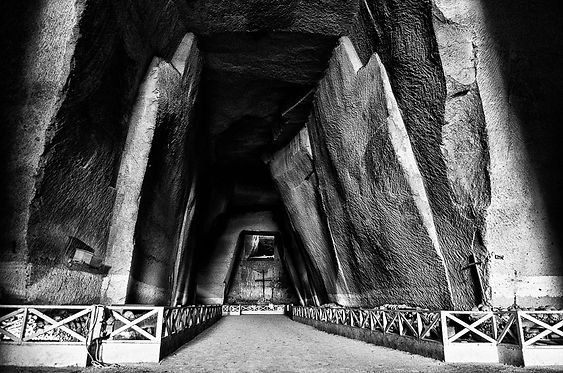Travelling Light
Between Life and Death
A journey through the Fontanelle Cemetery in Naples
The Fontanelle cemetery, in the Rione Sanità neighbourhood in Naples, is probably the most extraordinary manifestation of the unique relationship of the Neapolitans with the religion and the afterlife. A complex of caves a few minutes walking distance from the Materdei underground station, it is home to an extraordinary collection of skulls and bones of the thousands who died in the 1656 plague that almost decimated the city. It is also the place of religious practices, focused around the care and cult of the skulls.
Among the neighbourhoods of the capital of Southern Italy, the Rione Sanità is arguably one of the most interesting, mostly because of its position. Apparently underground when viewed from the eponymous bridge on the way to the Palace of Capodimonte, from which one can take an elevator that goes down for almost 30 meters (100 feet), a valley shadowed by surrounding hills. A geographic conformation that is quite unique in the city, characterised by steep ups and downs in sequence. One must in fact descend to reach the city, like Dante did when venturing through the afterworld.
It has an otherworldly reputation that dates back up to the Greek-Roman period, where the caves that were delved into the Capodimonte hill were first used to bury the dead and build catacombs. The place was favoured for the salubrity of its air, that cemented its reputation as a resting place for the ill (Sanità is the Italian word for health). The practice of excavating the underground, widespread in the city, led to the formation of a complex labyrinth of galleries and grottos that to this day has yet to be fully explored, now known as Napoli Sotteranea (underground Naples). These dark tunnels were not only the final resting place for the dead, but were also home to esoteric cults, magic practices and even secret meetings for the bandits that plagued the city. The advent of Christianity did not change much. The pantheon of gods was transformed into an ever-growing list of saints, to which the inhabitants of the city relied upon in order to solve the most common problems of everyday life. The cult of the saints is still to this day an important aspect of Neapolitan life, not only in the city but perhaps in the whole Southern Italy.
Since the nineteenth century, after its demise as public cemetery for the construction of the much bigger Poggioreale cemetery, at the Fontanelle (roughly translated as 'little fountains) began a popular movement spearheaded by the religious women of the neighbourhood, who, inspired by a strong piety for the dead, started to organize the huge mass of bones and skulls scattered all over the place, putting them beside the wall. The cult of the so-called 'anime pezzentelle' (the derelict soul of the owners of the skull) that resulted was immediately very popular among the Neapolitan. It consisted of an 'adoption' of a skull by an individual or a family, chosen in the dreams. The alive would give the soul-caring and prayers in order to ease the transition into Purgatory, the so-called rinfresco (refreshing). On the other hand, the anonymous skull would intercede at the supernatural authorities to grant to those who were alive help in both everyday and extraordinary moments of their life.
As a testimony of a received miracle, the people would often encase the skull in a niche, with a 'per grazia ricevuta' (for received grace) engraving on it. In order to exorcise the anonymity of the skull, numerous rumours rose around their past life. The skull of “Don Francesco”, a Spanish cabalist, was even attributed the power to predict the winning numbers. People would often stand by the cemetery gates at night in order to watch the shadows that the place would cast, interpret their meaning and from that obtain the desired numbers. The popularity of the cult and linked practices would last until the 1960s, when the religious authorities ordered its interruption, frowning upon the reports of magic practices and sorcery that frequented the place and fearing that the cult of the anime pezzentelle (derelict soul of the owners of the skulls) could transform into idolatry. The parallel secularisation of customs contributed to the abandonment of the cemetery and its closure, until the early 2000s, when it was eventually reopened to the public.
Today, stripped of all its supernatural and practical meanings, the place is almost exclusively visited by tourists, but it hasn't lost any of its intrinsic power to suggest and haunt. The immense vault sculpted in volcanic rock, the chill breeze that blows through the caverns, dark shadows only a bit mitigated by dim lights that reveal a startling view of skulls and bones, silence only interrupted by a few whispers, the awareness that one is never alone – always surrounded by thousands and thousands of souls, amassed there by a four century process – make the whole experience an occasion to reflect upon the never changing duality of life and death.
To see more from Stefano you can visit his website and Flickr.
 Tourists and Pasolini in front of Santa Chiara monastery |  Road dirt in via San Marcellino |
|---|---|
 Vendress in via San Gregorio Armeno |  Via Santa Chiara |
 Little church in a side alley |  Side alley |
 Craftsmen in via San Gregorio Armeno |  State archives |
 Graffiti in via San Biagio dei Librai |  Pignasecca market |
 Nile statue |



